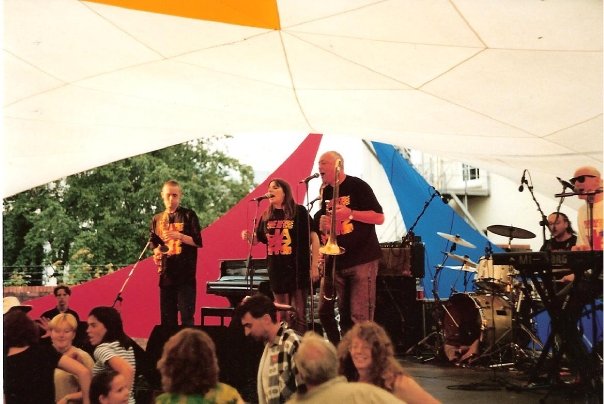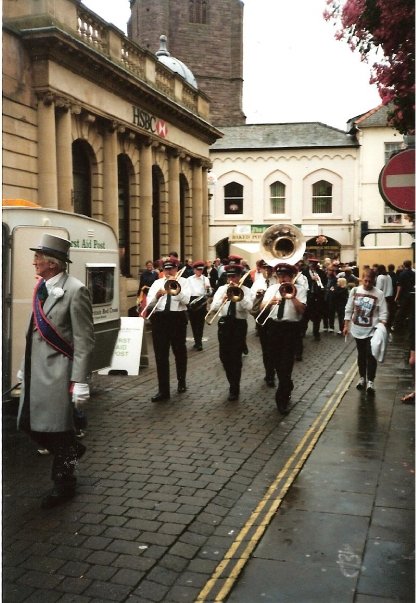Brecon Jazz Festival

SINCE 1984, the Brecon Jazz Festival has annually attracted music lovers and internationally-renowned jazz players and singers to the bustling market town of Brecon, at the top edge of the glorious Brecon Beacons National Park.
The festival, initiated by the Brycheiniog Association in association with the Welsh Jazz Society, proved an instant hit.
That first festival was organised by Jed Williams, owner of The Four Bars Inn, and started on August 17, 1984.
The famous English jazz and blues singer George Melly, who had a house nearby, was among the inaugural performers.
Melly was so taken with the event that he even described it as being similar to a New Orleans festival, with music blasting out from pubs, street parades, and other locations. According to Melly, it was “an exciting mayhem”.

Normally staged in early August, Brecon Jazz has played host to a range of jazz musicians from across the world. As well as the main festival, a Brecon Fringe Festival organises alternative free music in pubs, hotels, galleries and cafes in the town.
Programmes of music over the festival weekend have included:
Free music open to everyone, performed on the bandstand in the centre of Brecon and on streets closed off to traffic for the festival weekend;
The Stroller Programme, requiring the purchase of a ‘stroller ticket’, with acts from the British jazz scene performing in smaller indoor and larger outdoor venues;
The Concert Programme showcasing major acts with an international profile. Every concert requires an individual ticket.
Camping is popular at the festival, with two official campsites open to ticket holders and several independent campsites in the Brecon area. Hotels and bed and breakfasts are also available, but high demand usually means that early booking is required.
Inside a decade, the Brecon Jazz Festival earned a reputation as being one of the premier music festivals in Europe and, in 1995, obtained an award called the Schroder/Wales Tourist Board ‘Best Arts & Culture’ award.
Brecon had quickly become one of the most beautiful and atmospheric places to showcase jazz and by the early 2000s the programme began to include a more eclectic range of music, attracting well-known performers such as the outstanding singer-songwriter Amy Winehouse (2004).

It has not all been plane sailing, however. The festival was almost cancelled in 2009 due to lack of funding, but the Arts Council of Wales stepped in to allocate an amount of budget in order to help.
And the Covid-19 pandemic of 2020 meant that Brecon Jazz would have to think outside the box in order to ensure that the iconic festival would continue its unbroken run of 37 years. A ‘Virtual Brecon Jazz Festival 2020’ was hastily arranged, with a host of free shows and talks made available online.
Among the headline acts who have performed at the Brecon Jazz Festival over the years are:
1984 Humphrey Lyttelton, George Melly, Bruce Turner, John Barnes
1985 Jan Garbarek, Slim Gaillard, Stan Tracey, Ken Colyer
1986 Al Grey, Buddy Tate, George Chisholm, Dudu Pukwana
1987 Joe Henderson, Helen Shapiro, Woody Shaw, Pasadena Roof Orchestra
1988 Lee Konitz, Humphrey Lyttelton, Slim Gaillard, Louisiana Red
1989 Sonny Rollins, Jimmy Giuffre, George Melly
1990 Humphrey Lyttelton, Sun Ra, Scott Hamilton
1991 Gerry Mulligan, Ruby Braff, Joe Pass
1992 Michel Petrucciani, Johnny Griffin, Pat Metheny, Courtney Pine
1993 Lionel Hampton, Stéphane Grappelli, Wynton Marsalis, Hank Jones, McCoy Tyner
1994 Benny Carter, George Shearing, Slide Hampton, Ray Brown
1995 Cleo Laine, Toots Thielemans, Kenny Barron, McCoy Tyner
1996 Van Morrison, Joshua Redman, Phil Woods, Charles Brown
1997 Milt Jackson, Hank Jones, Courtney Pine, Diana Krall
1998 Branford Marsalis, Van Morrison, Michel Petrucciani, Ahmad Jamal
1999 Ruby Braff, Stan Tracey
2000 Wayne Krantz, Kenny Barron, Scott Hamilton
2001 Van Morrison, Joshua Redman, Dianne Reeves
2002 Courtney Pine, Scott Hamilton, McCoy Tyner
2003 Humphrey Lyttelton, George Melly, Richard Galliano
2004 Amy Winehouse, Humphrey Lyttelton, George Melly
2005 Phil Woods, Peter King, Jon Faddis, Marty Grosz
2006 Stan Tracey, Kirk Lightsey, Gwilym Simcock
2007 Catrin Finch, Mulgrew Miller, Joe Lovano, Jools Holland
2008 Joan Armatrading, Cerys Matthews, Courtney Pine
2009 Anouar Brahem, Manu Dibango, Abdullah Ibrahim
2010 Hugh Masekela, Orquesta Buena Vista Social Club, Hypnotic Brass Ensemble
2011 Allen Toussaint, Femi Kuti, Monty Alexander, Courtney Pine
2012 Dionne Warwick, Roy Ayres, Soweto Kinch
2013 Jools Holland, Courtney Pine, Mavis Staples
2014 Laura Mvula, Gregory Porter, Loose Tubes
2015 Robert Glasper, Phronesis, GoGo Penguin
2016 Dennis Rollins, Nerija, Kizzy Crawford, Dowally, GSD Ensemble, Carvela, Asterope, Dani Sicari and the Easy Rollers, Lieko Quintet, Wonderbrass, Bahla, Artephis, Jacqui Dankworth, Andy Nowak Trio, Simon Deeley Quartet, Capital City Jazz Orchestra, Tina May, Geoff Eales, Brownfield Byrne, Trish Clowes

* In 2009, in honour of the 50th anniversary of the release of the Miles Davis album, Kind of Blue, the festival invited jazz fans to submit nominations for an award, in the form of a Blue plaque to be awarded annually, the first to be bestowed in 2010, honouring the venues which had made the most significant contribution to jazz in the United Kingdom.
Twelve nominees were selected: The Four Bars Inn (later Dempseys, now Elevens), Castle Street, Cardiff, 1987 onwards; Band on the Wall, Swann Street, Manchester, 1970s-present; The Perch, Binsey Lane, Binsey 1928–1948; Buckingham Palace, London, 1919–1932; The Old Duke, King Street, Bristol, late 1960s-present; The Concorde Club, Eastleigh, Hampshire, 1957–present; The Feldman Swing Club, Oxford Street, London, 1942–1954; Ronnie Scott’s, Frith Street, London, 1959–present; The Bull’s Head, Barnes, south-west London, 1959–present; Hippodrome, Cranbourn Street, London, 1900–1983; Hammersmith Palais, London, 1919–2007; Club Eleven, Windmill Street, then Carnaby Street, London, 1948–1950.
The Concorde Club received the most votes in the initial voting, followed by The Band on the Wall and Ronnie Scott’s, to receive the initial (Kind of) Blue Plaque.